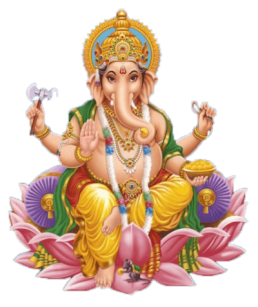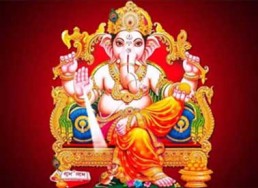Ganesha Gayatri Mantra
तन्नो दंतिः प्रचोदयात्
tanno dantiḥ pracodayāt

Description
Gaṇapati Gāyatrī: In the Gayatri of each form of God, there are the words vidmahe, dhimahi and tannaḥ pracodayāt. It is a prayer which means, ‘We meditate as we know You or have heard of You. May You enlighten us or inspire us.’ In between these words, three names specifying the particular form of God, to whom we pray and meditate upon are mentioned. In the case of Ganapati Gāyatrī, the names are eka-danta (one-tusked one), vakra-tuṇḍa (one with trunk turned towards the right or left – not straight) and danti – one with tusk. All three names refer to the elephant face of Ganapati.
‘O Lord Ganapati, we meditate on Your divine form as we have heard of You, do guide us on the right path, do inspire us to walk the spiritual path and do enlighten us with knowledge of Your true nature.’
Other Ganesha Shlokams
Agajanana Padmakam
We meditate day and night on the one-tusked one who is the sun for the lotus in the form of the face of Pārvatī, the one with the elephant face and the one who is the giver of all desired ends to his
Gajananam Bhuta
I bow to you, the Lord with the face of an elephant (Gajanana), one who is served by the celestial attendants (Bhoota ganas) and other beings. The one who consumes the extract of Kapitha (wood apple)
Gananamtva Ganapatim
Among the celestial attendants (Ganas), you are the Lord (Ganapathi), We offer sacrificial oblations to you You are the wisest among the scholars. Your wisdom is known to be highest quality and uncomp
Ganapathi Atharvashirsha
The Ganapati Atharvasirsha Upanishad is a Sanskrit text and a minor Upanishad of Hinduism. It is a late Upanishadic text dedicated to Ganesha, the deity representing intellect.
Ganapati Stotram
As the rays from the lotus-face of Gauri (Devi Parvati) is always on her beloved son Gajanana (Who has the face of an Elephant), Similarly, the grace of Sri Ganesha is always on his devotees; Granting
Ganesh Chathurthi
Significance of Ganesh Puja, Vinayaka Chavithi or Chathurthi. See how to prepare for Ganesha Pooja, How to perform the Puja with Video instructions and enjoy Audio devotional songs, uninterrupted and without ads.
Ganesha Pancharathnam
The composer, Guru Sri Adi Shankaracharya had praised the God Ganesha by presenting these five stanzas as five jewels, hence the name Maha Ganesha Pancharatnam.
Ganesha Stavah
Ganesha Stavah or Ganapati Stavah is a set of 13 verses that describe the glory of Lord Ganesha. Gaṇapati stavaḥ is said to be from Ganesh Purana - upāsanā khaṇḍa adhyāya 13.
Mooshika Vahana
Salutations to Sri Vighna Vinayaka, whose vehicle is the mouse and who has the modaka in his hand, whose large ears are like fans and who wears a long sacred thread, who is short in stature and is th
Sankata Nashana Ganesha Stotram
This stotram is from Narada Purana. Sankata means problems, difficulties and Nashanam means to destroy. So, by chanting this stotram one is praying to Lord Ganesha to remove his difficulties. In Sanskrit, English Translation, Meaning, Significance…
Shuklambaradharam
I meditate upon (Lord Ganesa), the one who wears a white garment, who is all-pervasive, who has a (bright) complexion like the moon, who has four hands, who has a cheerful face, for the removal of all
Vakratunda Mahakaya
O god with the twisted trunk, broad-bodied, brilliant as thousand suns, bless me with freedom from obstructions and hindrances in all my works and for all times.
Ganesha Gayatri Mantra – Ganesha – In Sanskrit, English Translation, Meaning, Significance and Audio.


